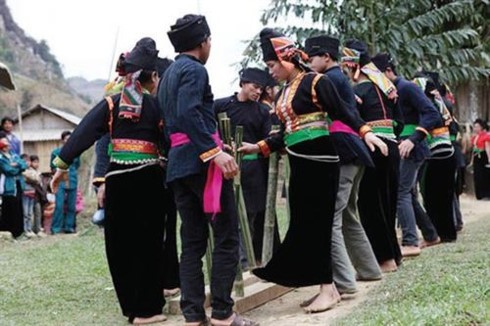Like several other Vietnamese ethnic groups, La Ha people attach great importance to their new rice worshipping ceremony to thank their Genies and ancestors for bumper harvests.
“At harvest time, we organize a new rice worshipping ceremony to show our gratitude to the genies, invite our ancestors to join our celebrations, and pray for more bumper crops and good health for all family members,” said a La Ha man named Quang Van Chung who lives in Son La province.
When the paddy fields turn yellow in September or October, a good day is selected on which a mother and her daughter-in-law will cut some rice in the field and bring it home for the new rice worshipping ceremony.
Before cutting the rice, they perform a small ritual to pay respect to the rice. The ritual offerings include a chicken, a duck, a pig, a jar of wine, and two bottles of wine.
They also prepare some steamed sticky rice and drinks for their relatives and friends, who come to help them with the harvest. All the food is cooked at home and brought to the paddy fields. A shaman is invited to conduct the ceremony.
Lo Van Doi, a La Ha man who lives in Son La province, said his family has performed the new rice worshipping ceremony since he was little.
“My family prepares cooked chicken and duck meat as offerings to the local land genies. We believe this will bring about bumper crops. We only harvest the rice after the ceremony is done,” said Lo Van Doi.
Following a small ritual organized besides the paddy fields, the main new rice worshipping ceremony is held at home. A tray of offerings is prepared with chicken, a jar of wine, white wine, vegetables, fruits, and other local agricultural products.
A special dish made from young sticky rice is an indispensable part of the offerings to the deities and ancestors. The tray is placed at the center of the stilt house and a shaman is invited to conduct the ceremony.
After the ceremony is finished, the house owner is supposed to be the first in the family to eat the cooked rice to ensure future bumper crops.
“My family still practices this tradition of organizing a new rice worshipping ceremony every year. The mother of the family and her eldest daughter-in-law are supposed to go to the fields, cut some ripened rice and take it home to cook in preparation for the ceremony. During the ceremony, our ancestors are invited to enjoy the offerings and be informed that a new harvest is about to begin,” said Doi.
Although the small ritual beside the paddy fields is no longer performed, the new rice worshipping ceremony is still held at home, where all family members and relatives come to strengthen their bonds and celebrate their wealth and happiness.




